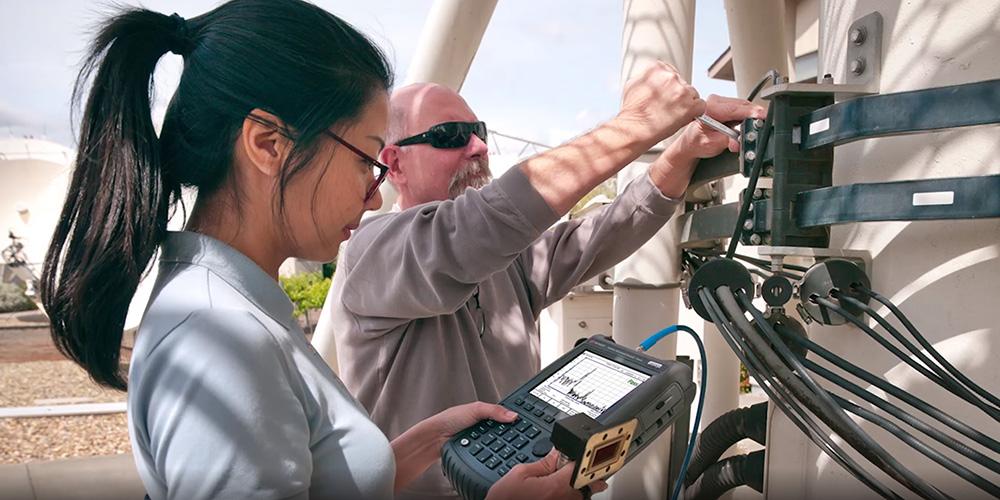How Tech Companies Benefit from Multigenerational Teams
By Leslie Camino

Continuously pushing the boundaries of technology requires a constant give and take between learning from the past and moving forward into the unknown. A multigenerational workforce can provide the necessary ingredients for continuous disruptive innovation by creating productive tension between the past and future, so teams don’t get stuck in one mindset.
While managing a multigenerational team comes with unique challenges like navigating differences in experience, expectations, and communication styles – creating an environment where individuals in various stages of their career journey can collaborate is a major competitive advantage for tech companies.
Keysight goes back more than 80 years and has five generations of employees in its global workforce today. Over the years, we have found that having such a wide diversity of age presents opportunities for Keysight to foster knowledge sharing, embrace new perspectives, and reduce turnover.
As Keysight’s Senior Director of Corporate Leadership Development and Diversity, Equity and Inclusion, I work closely with leaders across the organization to maximize the potential of our talented and diverse teams. For example, Qi Gao, one of our senior software managers, has four generations across her team and finds the age diversity injects new energy into the current systems and practices. She’s not alone.
In this article, I’ll share four ways Keysight and our employees have benefited from a multigenerational workforce.
Unique advantages of a multigenerational workforce
When employees of all backgrounds feel heard, respected, and appreciated, they reach their full potential. It creates a workplace environment where team members collaborate, share new ideas, and feel committed to the company mission.
In our case, we observe heightened contribution and improved business value in the following ways:
Increased creativity and innovation
We recently wrote about the importance of diversity in innovation, and just like diversity of race, gender, and cultural backgrounds, and other dimensions, diversity of age and experience is extremely valuable on a team. Employees from different generations learn from each other, opening their minds to new perspectives and ways of thinking.
In the technology industry, as solutions become ever more complex and interconnected, having teams made up of varying age groups that can generate a greater, and more diverse, pool of ideas results in a more robust product that works for a broader set of customers. Their unique generational perspectives ensure we address product features, user interfaces, and accessibility enhancements that cover broad needs and preferences.
Maintaining institutional knowledge
One of the biggest downsides of employee turnover is losing institutional knowledge. By fostering communication between employees of different generations, we ensure the expertise remains in the company as employees retire or change jobs.
Attrition rates at Keysight are lower than the average in the tech industry, which means we accumulate valuable institutional knowledge. Still, people move jobs within the company at a healthy rate to support their career development, so constantly ensuring knowledge is shared among team members is critical. When I recently spoke with Ken Nishimura, Ph.D. who oversees Keysight’s research and development team, we discussed the ways that instituting cross-training as an ongoing practice has been a big part of what makes his team successful.
Staying ahead of the latest technology trends
It’s easy for employees of all ages to simply do things the way they’ve always done them. But in the technology industry, that mindset doesn’t work when you’re trying to stay ahead of competitors.
That’s why it’s been important for us to embrace the next generation of thinking and stay on top of the latest trends. Universities are at the cutting edge of research and innovation, so hiring engineering graduates from universities can bring in the newest ideas to help teams understand how the field has progressed.
Going back to my conversation with Ken, he shared that everyone brings something to the table. And that we want extract new ideas, tools, and ways of doing things from the next generation of engineers. At the same time, we want to pass on the knowledge of experienced employees so the new generation can build on the learnings of the previous one.
Reducing turnover with a strengthened sense of belonging
In the fast-paced technology industry, companies compete with each other to attract the best talent. As a result, the industry experiences high turnover rates, The Great Resignation or the Great Reshuffle of 2021, in particular, is driving even greater turnover. According to Harvard Business Review, resignation rates have increased in mid-career employees by 20% and in the tech industry by 4.5%.
At Keysight we aim to foster a culture that enables employees to spend their careers with us That means we need to value employees at all stages of their career and to develop a collaborative environment that fosters a sense of belonging and loyalty – to ultimately minimize employee turnover.
Speaking with our R&D managers there’s a consensus that we benefit from the new generation because of the ideas they can bring in, and from experienced engineers for their insights. We as a company are stronger for their unique contributions.
Creating a sense of belonging has real business value
A multigenerational workforce provides the valuable perspectives needed to maintain competitive advantage and enables the continuation of our strong cultural DNA. It not only benefits employees, who can grow and learn from each other, but is essential to support our mission to accelerate innovation to connect and secure the world.

